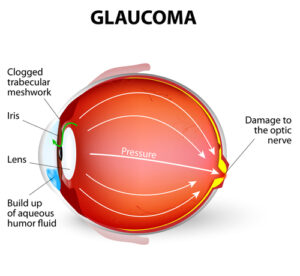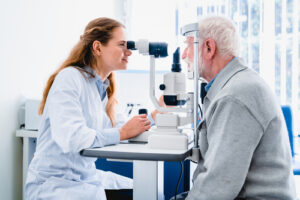Glaucoma is one of the leading causes of blindness. But what’s scariest about this eye condition is there are few, if any, symptoms that go along with it. Keep reading to learn more about glaucoma and how patients can better understand if they have it.
What is Glaucoma?

Glaucoma is one of the leading causes of blindness in Americans over 60. It’s often called “the silent thief of sight” because it is asymptomatic in its early stages.
People with glaucoma might not know they have it until their vision begins to be affected. Glaucoma occurs when the fluid in the eye, known as aqueous humor, does not properly drain from your eye.
As this fluid collects, it causes increased pressure within the eye, which then causes irreversible damage to the optic nerve. If left untreated, glaucoma can impair vision, from blind spots to complete vision loss.
Blind spots are an early indicator of glaucoma, though often, by the time blind spots are noticed, serious damage to your optic nerve fibers has already occurred.
What are the Symptoms of Glaucoma?

Many people find out they have glaucoma at their annual eye exam. Before diagnosis, people with glaucoma may have no symptoms at all.
If there are symptoms, these may be symptoms that patients think are caused by other health conditions. Some early symptoms reported by people eventually diagnosed with glaucoma include hazy vision or blind spots in their peripheral vision, halos around lights, sensitivity to light, eye redness, eye pain, and headaches.
People with a specific type of glaucoma, angle-closure glaucoma, often are diagnosed with the eye condition after symptoms occur all at once.
How is Glaucoma Diagnosed?

When you go in for a regular comprehensive eye exam, your eye care provider will perform a tonometry test to measure the pressure inside your eye. It is a simple, painless test that is a routine part of almost every eye exam.
To perform a tonometry test, your eye care provider will have you rest your forehead and chin against the slit lamp device they will have used for other eye tests. They will then blow a small puff of air directly onto your cornea.
During this test, your eye care provider observes how much the air flattens the cornea to determine if your eye maintains the correct pressure. If they don’tdon’t perform this test, they may use a different instrument to measure intraocular pressure instead.
What are the Types of Glaucoma?
There are two major types of glaucoma: primary open-angle glaucoma and angle-closure glaucoma, sometimes known as closed-angle glaucoma or narrow-angle glaucoma.
Primary Open-Angle Glaucoma
Primary open-angle glaucoma is the most commonly diagnosed type of glaucoma. This type of glaucoma happens gradually, as the eye starts being unable to drain intraocular fluid as well as it should, causing increased pressure in the eye.
This type of glaucoma is painless and does not cause immediate vision changes as it causes pressure to build up.
Angle-Closure Glaucoma
Angle-closure glaucoma occurs when the area that drains fluid in the eye is blocked by the iris, trapping fluid at the front of the eye and resulting in a rapid pressure buildup. While many people with angle-closure glaucoma develop it slowly, they are unaware they have glaucoma until they experience an “acute attack,” which is the sudden onset of angle-closure glaucoma symptoms.
Symptoms of an acute attack include sudden and severe eye pain, blurred vision, headache, nausea, and eye redness. If you experience these symptoms, it is a true eye emergency, and you should immediately seek medical attention.
Less common types of glaucoma are normal-tension glaucoma, pigmentary glaucoma, and glaucoma in children.
What are the Risk Factors for Developing Glaucoma?
While anyone can develop glaucoma, you may be at a higher risk of developing this eye condition if you fall into any of these categories:
You are Over 60

Aging affects the structures of the eye, causing them to work less effectively. As you age, your optic nerve may not be able to tolerate the increased eye pressure caused by glaucoma.
You are African-American and Over 40
Studies are not conclusive, but statistics show that this segment of the population is five times more likely to develop cataracts.
You Have a Family History of Glaucoma
Open-angle glaucoma, the most common type, is hereditary. Additionally, you are far more likely to develop glaucoma if a parent or sibling is diagnosed with the eye condition.
You Have Diabetes
Diabetic retinopathy is a side effect of diabetes that damages the blood vessels in your eye and can lead to the growth of abnormal blood vessels. These abnormal blood vessels can block your eye’seye’s natural drainage system, increasing pressure within the eye.
What are the Treatments Available for Glaucoma?

While there are no known cures for glaucoma, treatments are available that can help slow down the progression of the disease. Today, a glaucoma diagnosis no longer leads to the inevitable loss of your vision.
Glaucoma treatment aims to reduce the pressure within the eye that causes damage to the optic nerve. Eye care providers can use prescription eye drops, oral medications, surgery, or a combination of treatments to lessen the damaging effect of glaucoma.
Treatments for glaucoma are most effective when you receive a diagnosis of glaucoma in its early stages. Because there are usually no warning signs, you must schedule regular comprehensive eye exams, especially if you have any of the risk factors for the eye condition.
While losing your eyesight to an eye condition with no early symptoms can be frightening, it is reassuring to realize that early detection and treatment can prevent permanent vision loss. Partnering with an experienced and knowledgeable eye care provider, like Batra Vision Medical Group, can ensure your eyes stay healthy, even if you have glaucoma.
Want more information about glaucoma and how best to treat it? Request an appointment at Batra Vision in San Leandro, CA, today!

 Follow Us!
Follow Us!